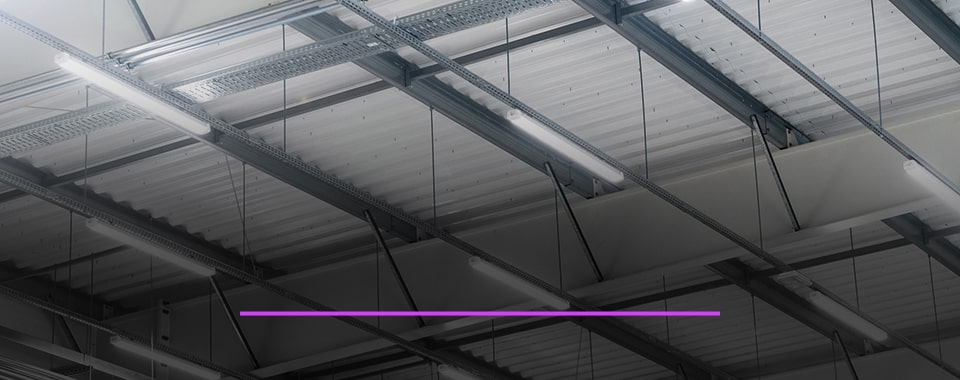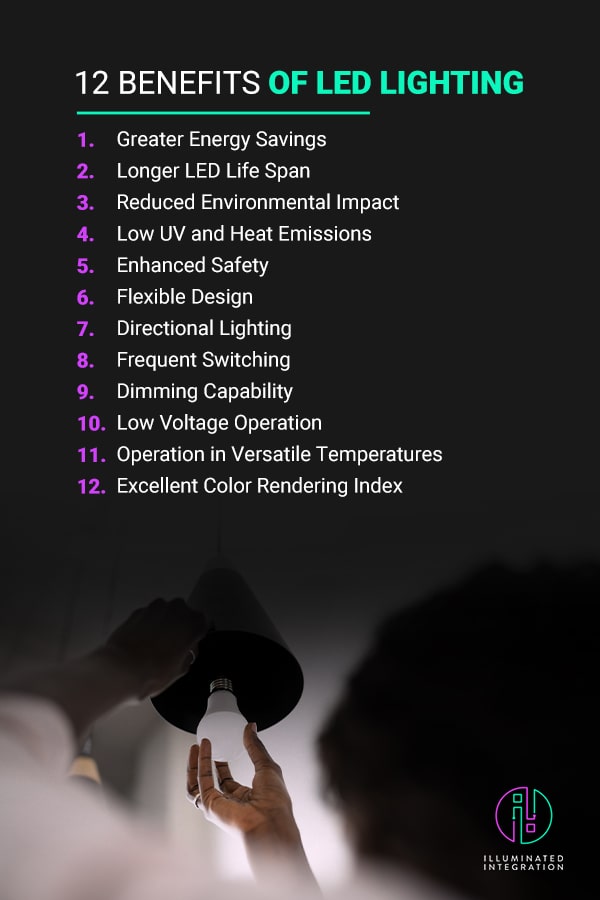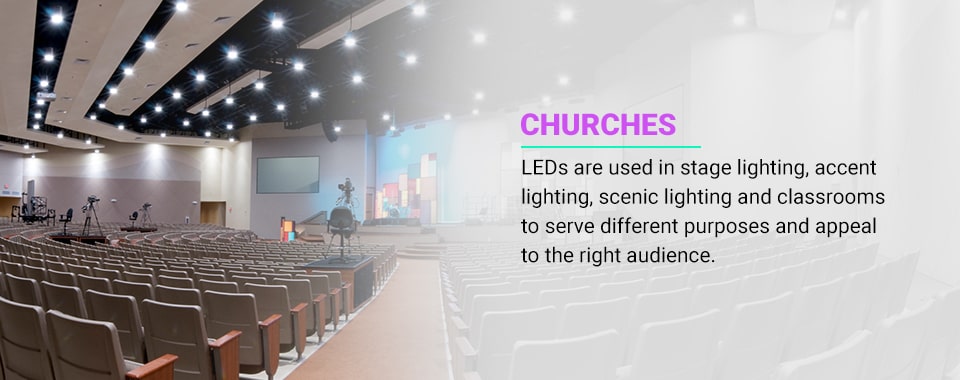

LED lighting technology is popular worldwide because of its superior efficiency and life span compared to other light sources. LED lights provide benefits ranging from increased energy savings to reduced environmental impact that can transform how the world uses light. Based on these and other LED benefits, many individuals and organizations are exchanging their incandescent or compact fluorescent lighting (CFL) for LED bulbs. LED lighting is the world’s leading light technology, comprising over 50% of global lighting sales.
If your facility or venue is considering switching to LED lighting, understanding the advantages of LED can help you decide whether this lighting technology is the best. Learn more about the benefits and uses of LED lights below.
LED lighting is a type of lighting technology that uses light-emitting diodes (LEDs) to create light. LED products contain semiconductors that emit visible light when an electric current flows through them. This reaction releases energy in the form of heat and photons, which are light particles. The process responsible for producing LED light is called electroluminescence.
An LED light has several components working together. These parts include:
The color of LED light is determined by the energy required for the electricity to pass through the semiconductor. To create white light, multiple semiconductors are used in the LED light. Manufacturers can also apply a layer of phosphor, a light-emitting substance, on the semiconductor to produce white light.
LED lights were first used in expensive laboratory and test equipment. These early LED lights were extremely expensive and impractical for widespread use. Eventually, as their design was refined, these replacements for incandescent bulbs became more affordable and widely used across various applications.

LED lighting provides many advantages to organizations compared to other types of lighting technology. Consider these advantages of LED lights and how this technology can benefit your facility:
Using LED benefits companies that want to reduce energy costs, as this lighting technology is much more energy efficient than alternative lighting sources. Energy efficiency is measured in luminous efficacy or useful lumens. These terms describe the amount of light a bulb emits for every watt of energy it consumes. LED lighting produces more useful lumens and wastes less energy than other light sources.
The energy savings you can expect from LED lights depends on your facility’s existing lights and the specific LEDs you install. For example, switching to LEDs from incandescent bulbs could result in an efficiency improvement of 90%. Better energy efficiency translates into greater savings.
One of the most significant LED advantages is the longer life span of the bulbs. An LED bulb can last three to five times longer than a CFL bulb and up to 30 times longer than an incandescent bulb.
Depending on how you use your lights, you may be able to use them for thousands of hours longer than other light sources. You may be able to keep using an LED light for years after you would have had to replace an incandescent one. This difference in life spans of these light sources significantly reduces your facility’s maintenance and replacement costs.
Companies and organizations realize the importance of reducing their environmental impact. Using environmentally friendly lighting sources can help companies comply with governmental regulations, reduce their energy use and attract environmentally conscious customers.
The reduced energy use associated with LED lights has a significant positive effect on the environment. According to the International Energy Agency, LED lighting is the most efficient of any light source available on the market, producing an average of 11 lumens per watt. Many countries worldwide are phasing out less-efficient technology in favor of LEDs, and increased adoption of LED lighting is necessary for achieving Net Zero Emissions.
LED lights emit most of their energy as visible light, a small amount in the infrared spectrum and hardly any in the ultraviolet spectrum. Because LED lights don’t emit UV waves, they are ideal for safely illuminating sensitive items like artwork that could become damaged if exposed to this emission.
LEDs also hardly emit any heat, especially compared to other light sources. For example, incandescent lighting releases 90% of its energy as heat, leaving only 10% of its energy for light production. This contributes to the low energy efficiency of incandescent bulbs.
The benefits of LED lighting on the environment also include better safety for people and the planet. Two traditional light sources — mercury vapor lights and fluorescent lighting — contain mercury in their bulbs. At the end of these bulbs’ life span, they require special handling to avoid mercury exposure or release, which can be toxic to human health and the environment.
LED lights don’t contain mercury in the bulb because they produce light using semiconductors. Using LED lighting eliminates the need to worry about safely disposing of the bulbs.
If your facility is looking for a lighting source that can work in several different applications, LED lights are the solution. LEDs are small, about the size of a flake of pepper. There are countless ways to use these tiny LEDs to enhance almost any environment. The versatility of LED lights gives them tremendous flexibility in their uses. LED lights work just as well in small devices as illuminating massive sports arenas.
Traditional light sources emit light at 360 degrees around the bulb, lighting every direction equally. However, your facility may need directional lighting to illuminate a specific area, like a stage, sign or piece of artwork. You’ll have to invest in additional devices to reflect or redirect the light to obtain directional lighting from an incandescent or CFL bulb.
LED lights are ideal for applications that require directional lighting. These bulbs emit light in a specific direction, eliminating the need for adding light reflectors to your lighting system. This characteristic makes LED lights more efficient than light sources that require redirection. LED lighting also saves your facility the cost of installing accessories to your lighting system.
Fluorescent and metal halide lights require a couple of seconds before they turn on fully. This warm-up time delays your lighting and will eventually degrade the light source if you frequently switch them on and off. Whether you want your lights to turn on instantly after a power surge or when an employee opens the door, traditional light sources aren’t the best solution.
In contrast, LED lights turn on and off instantaneously and can withstand frequent switching without losing efficiency. This feature makes LEDs perfect for light installations that switch colors, like LED walls or flashing light displays.
Sometimes facilities need to dim their lights, whether to create a specific ambiance or conserve energy during certain times of the day. Traditional light sources like metal halide lamps perform less efficiently when dimmed and may not dim at all.
LED lights perform well at any percentage of rated power, anywhere from 5% to 100%. The efficiency of these lights isn’t negatively affected by dimness. In fact, you can increase the efficiency of your LED lights by dimming them. An LED light’s dimming capability enables facilities to extend each bulb’s life span and reduce energy costs.
In certain situations, such as in geographic locations where your facility could become flooded, having lights that operate on low voltage can be a significant benefit. Low-voltage light systems can protect anyone inside the building from harmful electric shocks if the building is flooded.
LED lights are ideal for these areas because they operate on low voltages. This means your bulbs can help protect employees and customers who may be inside during a flood. Their low voltage also makes LEDs ideal for use outdoors when other types of lighting don’t meet building codes, such as in flood zones.
Some traditional lighting sources don’t do well in cold temperatures. Incandescent lights, for instance, require a higher voltage to power on if they become too cold. This characteristic isn’t ideal for illuminating cold spaces like freezers and meat lockers. The intensity of incandescent light also diminishes in colder environments, making this light source less efficient.
LED lights work well in a wide range of temperatures, making them ideal for applications in cold and hot areas. LEDs work efficiently in areas such as parking lots, building perimeters and refrigerated display cases.
A light’s color rendering index (CRI) is its ability to illuminate the colors of objects compared to natural light. Some light sources have a better CRI than others. For example, sodium vapor lamps have a low CRI and tend to create almost a monochromatic environment around them, washing out the nuances of color. In comparison, LED lights tend to have a high CRI, clarifying the distinctions between the colors they illuminate.
Now that you understand the advantages of LED lights, you may be wondering whether those advantages apply to your industry. Understanding what LED lights are used for can help you visualize how to utilize the technology in your facility. Here are the various uses of LED lights:

One of the most common LED uses is in theaters. A theater’s lighting system is critical for bringing to life the movements, dimensions and moods on stage. Performances may use color, patterns and movement in their stage lighting to help create the effects needed for each scene. Theaters also use house lights and performance-dimmed lights in the audience.
Efficient lighting is essential in sports venues, where spectators and players must see the game in action within the stadium. Stadium lights must be bright, dependable and efficient. Sports venues must also be well-lit in other areas, including restrooms, vendors and parking lots. These venues often choose LEDs over other light sources. The energy efficiency, sophisticated controls and color rendering that LED lights provide make them an excellent choice.
There are many uses for LEDs in corporate spaces. From company headquarters and retail centers to hotels, all kinds of corporate spaces use lighting to enhance their brand, send a message to customers and enhance productivity. LED lighting provides the energy efficiency and versatility businesses need in their light installations. For example, a company may create ambient lighting with LEDs, install accent lighting or use LED walls to display completed projects for those who enter the building.
From city halls and courthouses to post offices and historic locations, government buildings need efficient lighting that sets a tone and operates reliably. Whether a government facility needs office lighting that encourages productivity or outdoor lighting that provides high levels of visibility, LEDs are the solution. LED lights allow these facilities to save energy, set the right tone and enhance security.
Museums use audio, visuals and lighting to create an ambiance for visitors and help enhance their exhibits. LED lighting installations are valuable for helping galleries and museums bring their exhibits to life. LEDs are ideal for illuminating artwork and artifacts that are sensitive to UV waves. LED lighting also provides plenty of design flexibility so museums can create unique lighting installations that engage patrons and emphasize the characteristics of various exhibitions.

Places of worship rely on lighting to draw worshipers into the service, create a welcoming environment and enable recording and livestreaming of the service. LEDs are used in stage lighting, accent lighting, scenic lighting and classrooms to serve different purposes and appeal to the right audience. LED lights are a great option whether a church needs performance lighting to highlight its speaker and band or ambient lighting to create a sense of quiet reverence.
Performance venues strive to create immersive experiences for the audience, whether the performance is a comedy show or a heavy metal concert. Lighting plays a crucial role in setting the scene and engaging attendees. A performance venue needs different lighting arrangements to cater to the needs of various performers, from dancing groups to musicians. A custom LED lighting system can help a venue attract performers, engross audiences and enhance the viewing experience.
For K-12 schools and higher education institutions, an auditorium is an important place where students and educators gather for learning, entertainment and informational events. A K-12 auditorium can use LED lights to enhance student performances, debates, public speaking events and more. A well-designed LED lighting system at universities enhances the campus’s value.
Themed entertainment centers like theme parks, nightclubs and restaurants use LED lighting to influence actions and emotions in the audience. Lighting helps coordinate a seamless and immersive experience for guests. Themed entertainment centers benefit from LED lighting’s versatility, efficiency, long life spans and ability to switch and dim lights as needed.
Lighting is crucial in healthcare settings, providing visibility and creating an ambiance that can help calm patients. LED lighting has numerous uses in healthcare facilities, from illuminating MRI rooms to providing visibility in hospital cafeterias. LEDs can meet the modern efficiency and design needs of places like clinics and urgent care centers.
LED lighting provides several significant benefits to companies and organizations that use it and to the environment. LED lights can reduce your facility’s energy expenditure, enhance safety and enable directional lighting that accurately illuminates colors. LED lights are also safe, have a low environmental impact and are extremely versatile. With applications ranging from hospitals to theme parks, LED lights have many uses.
At Illuminated Integration, we design, integrate and install audio, visual and lighting (AVL) systems for facilities in various industries. We work with you to determine your facility’s needs and create an original design that fulfills your vision. For help with your facility’s lighting project, contact Illuminated Integration.